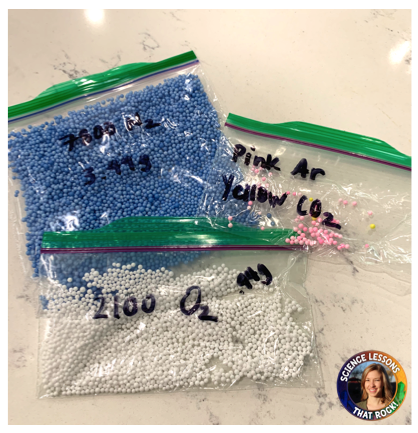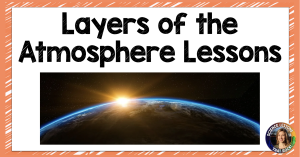Models can be powerful tools when teaching science. They allow students to visualize concepts that can be difficult to picture in their heads.If you ask students what the most abundant gas in the atmosphere is, their first guess is usually oxygen. And when you say no, their second guess tends to be carbon dioxide. When we talk about the composition of the atmosphere and the effect of greenhouse gases, students may picture the atmosphere being FULL of carbon dioxide… and rightfully so- statistics estimate that 45 billion tons of carbon dioxide are released every year. But how much is that?
I wanted to build a model of the atmosphere so students could see that there isn’t very much carbon dioxide in the atmosphere relative to other gases.
- To represent atmospheric gases, I found these colorful styrofoam spheres on Amazon (commonly used as bean bag filler). It was only a few dollars to order a set that came with 4 bags- a steal! I’ve also seem them for sale at dollar stores and craft supply stores like Hobby Lobby.
- Next, I decided if I wanted the atmosphere represented by 10,000 spheres, then 78% or 7,800 needed to be nitrogen, 21% or 2,100 would be oxygen, 0.93% or 93 would be argon, and roughly 4 would be carbon dioxide.
- Next, I needed to measure out the correct number of spheres to represent each color. Instead of counting out 10,000 blue spheres to represent nitrogen (ain’t nobody got time for that), I counted out 100 and weighed them on a sensitive electronic scale. I took the mass of the 100 spheres and did a little cross-multiply-and-divide to figure out how much 7,800 spheres of nitrogen would weigh. (If your scale doesn’t go down to the hundredths of a gram, you may need to count out more). I did the same thing for oxygen (represented in white).
- Next, I counted out 93 pink spheres to represent argon and 4 yellow to represent carbon dioxide.
- I poured them into a plastic container I found at the dollar store. I realized I wanted to scale it up a bit so I repeated steps 3 and 4 a few more times and kept adding to fill up the container.
- Lastly, I made a label and taped it to the top of the container so students can try and guess which colors represent which gas. If you would like to download the label, you can snag it here for free.
- (Optional) If you are worried about students opening up the jar and spheres going everywhere, stick some superglue on the lid before screwing on.
I like that it is easy to see how much nitrogen is in the atmosphere compared to oxygen and other gases. So much easier for students to visualize!I want to point out that whenever you use models in class, you need to discuss with students any limitations the model might have to avoid misconceptions.
- This model is limited to 4 types of gases. There are other gases in the atmosphere such as neon, helium, water vapor, and methane, but they are in such trace amounts I left them out of the model.
- The gases in our atmosphere are more dense near the earth’s surface and thin out as you go up in elevation. This is because gravity pulls down on the gases (and why it is difficult for hikers on Mt. Everest to breathe- there is a lot less oxygen up there!)
- If you teach chemistry, you might want to point out that not all gas molecules are exactly the same size, as they are in this model.
- It is good to discuss that even though carbon dioxide molecules are few in number, they still play a large role in global climate change.
- If you teach biology or environmental science and review the biogeochemical cycles, this can be a good time to point out that gases in the atmosphere aren’t static- they are constantly moving through cycles. Producers take in carbon dioxide and release oxygen during photosynthesis, consumers take in oxygen and release carbon dioxide during respiration, and bacteria take in nitrogen through nitrogen fixation. But it IS true that we are releasing carbon dioxide to the atmosphere faster than ever before.
Overall, the entire thing only cost me $9 to make and I had enough spheres left over to make another. Pretty cost efficient compared to ordering one from a science supply company!
Looking for more atmosphere lesson ideas? Check out this blog post!












